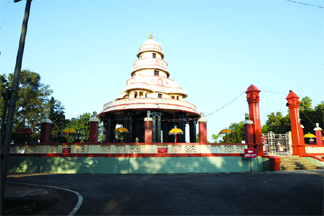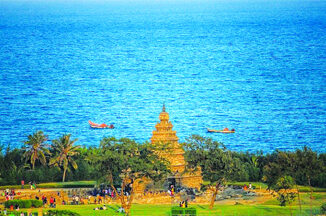
Known as the “City of Pearls” and the “City of Nizams,” Hyderabad is one of India‘s most captivating destinations. Situated on the banks of the Musi River, the city presents a fascinating mix of royal history, vibrant culture, delectable cuisine, and modern technology hubs. From its iconic Charminar to the bustling IT district of HITEC City, Hyderabad seamlessly blends the old with the new, making it a must-visit for travelers seeking both heritage and modern experiences.
A Glimpse into History
Founded in 1591 by Muhammad Quli Qutb Shah, Hyderabad grew into a flourishing cultural and commercial hub under the Qutb Shahi dynasty and later under the Asaf Jahi Nizams. The city became famous for its pearls, diamonds, and grand palaces, many of which still stand as testimonies to its regal past.
Places to visit
Charminar
The Charminar is the icon of Hyderabad as the Taj Mahal is for Agra or the Golden Temple for Amritsar.
The monument was built in 1591 by Mohammed Quli Qutb Shah, the fifth leader of the Qutb Shahi dynasty, after transferring his capital from Golkonda to Hyderabad. The Charminar was built at the intersection of the historic trade route that connects the markets of Golkonda to the port city of Machilipatnam. Originally, the town was divided around the Charminar in four quadrants.
The structure is of Indo-Islamic architecture, integrating Persian architectural elements. It has a mosque and 45 prayer rooms.
Mecca Masjid
Two hundred meters south-west of Charminar, one sees the Mecca Masjid (the mosque of Mecca), called this way because the bricks were brought back from Mecca to build the central arch. The Qutb Shahis rulers never finished building the mosque, it was completed by the Mughal emperor Aurangzeb in 1694.
Laad Baazar
Laad Baazar is the oldest market of the city nestled in one of the arteries that lead to the Charminar. He has been active since the days of the Qutub Shahis and Nizams. This bubbling and colorful market is famous for its pearls, semi-precious stones and traditional glass and stone bangles.
‘Laad’ indeed means ‘resin’ in reference to the resin used to insert the artificial stones and diamonds on the bracelets. If you have to buy bangles, the laad market is the perfect place.
Chowmahalla Palace
Located in the old city of Hyderabad near the Charminar, the Chowmahalla Palace is surely the most beautiful heritage building in Hyderabad. It consists of 4 palaces (Afzal Mahal, Mahtab Mahal, Tahniyat Mahal and Aftab Mahal) and was the seat of the Asaf Jahi dynasty and the official residence of the Nizams of Hyderabad when they ruled the city.
The palace remains the property of Barkat Ali Khan Mukarram Jah, heir to the Nizams.
Salabat Jung initiated its construction in 1750 and was completed during the reigns of Afzal ad-Dawlah and Asaf Jah V between 1857 and 1869.
Chowmahalla is unique for its style and elegance; Its architecture blends harmoniously different architectural influences. This is one of the first examples of European neo-classical architecture in Hyderabad.
The Khilwat Mubarak or Durbar hall, the hall of ceremonies, is the heart of the Chowmahalla Palace. It is adorned with 19 huge crystal chandeliers from Belgium and a platform of white marble on which the Takht-e-Nishan or the royal seat is laid.
Badshahi Ashurkhana
Hidden in a corner near the Charminar this “house of mourning” is worth the detour. The Badshahi Ashurkhana is a mourning place for the Shia Muslims built in memory of the martyr Imam Hussain. Iman Hussain was the grandson of the Prophet Muhammad and the son of Ali ibn Abi Talib, the first Imam Shiite. The exterior aspect of the building is modest but the mosaics inside are splendid.
Golkonda Fort
Golkonda is one of the famous forts of India and was the capital of the rulers Qutb Shahi. The origins of the fort date back to the Yadava dynasty of Deogiri and the Kakatiyas of Warangal. The first three Shahi kings of Qutb rebuilt Golconda over a period of 62 years. Golkonda consists of four distinct forts surrounded by a 10 km long outer wall. Inside are several apartments and royal halls, temples, mosques, stables, etc. It is said that Golkonda fort possessed a safe where the famous ‘Koh-i-Noor’ and ‘Hope’ diamonds were locked up. The fort remained the capital of the Qutb Shahi dynasty until 1590 when the capital was transferred to Hyderabad. The fort will fall in ruin from 1687 after a long siege of a year leading to the capture of the fort by the Mughal emperor Aurangzeb.
The seven tombs of
Qutab Shahi kings
About one kilometer from the Golkonda Fort are the seven tombs of the kings of the Qutb Shahi dynasty. These granite tombs are part of the oldest historical monuments of Hyderabad. Very elegant, they are built in Persian and Hindu architectural styles.
Hussain Sagar Lake
Hussain Sagar is a heart-shaped lake built by Ibrahim Quli Qutub Shah in 1563. It is spread over an area of 5.7 square kilometers and is fed by the river Musi. A large monolithic statue of Gautama Buddha, erected in 1992, stands in the middle of the lake. the lake also separates Hyderabad from its twin city Secunderabad. Boats often return from the lumbini garden to the statue.
Birla Mandir
Birla Mandir is a Hindu temple, built on an 85-meter hill called Naubath Pahad. The construction lasted 10 years and was inaugurated in 1976 by Swami Ranganathananda of the Ramakrishna Mission. The temple was built by the foundation of the wealthy industrial Birla family, who also built several similar temples in India, all known as Birla Mandir. The temple, built with 2000 tons of pure white marble is a mixture of dravidian, rajasthani and odishi architecture.





Howdy! Do you know if they make any plugins to help with SEO? I’m trying to get my blog to rank for some targeted keywords but I’m not seeing very good results. If you know of any please share. Many thanks!
Useful info. Fortunate me I found your site unintentionally, and I’m shocked why this coincidence didn’t took place earlier! I bookmarked it.
Saved as a favorite, I really like your blog!
cyv3aa
I haven’t checked in here for a while since I thought it was getting boring, but the last several posts are good quality so I guess I’ll add you back to my everyday bloglist. You deserve it my friend :)